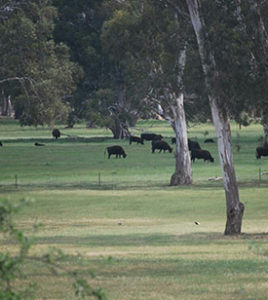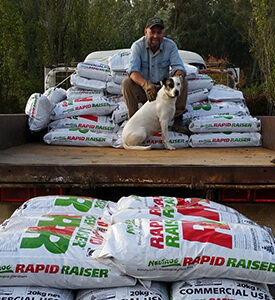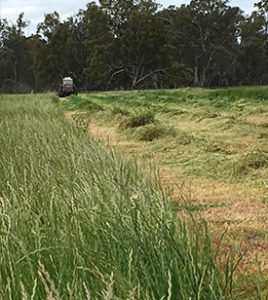‘Loddon Lea’, the farm of Rick and Helen Lovel, is located at Eddington in Central Victoria and has been carefully developed to maximise the year-round grazing for their Black Angus cattle herd.
Divided into four main paddocks, the property is flanked by river flats, including one large bay and six smaller bays. For the Lovels, a careful approach to rotating livestock across the property and an efficient irrigation programme are key in managing a productive pasture base.
“Carrying quite a few head for the size of the farm requires careful planning”said Rick.
“I irrigate a number of times a year and need to time it to ensure that I can keep the cows off for long enough so that pasture grows back vigorously. We have a beautiful natural pasture with plenty of white and strawberry clover throughout. Once a year when irrigating, I’ll run GOGO Juice through each bay. I’ve always understood the importance of the soil’s biology, and the first year I applied GOGO Juice I couldn’t believe the size of the clover”.
The river flats are sown every year by Rick, with the help of his brother Mark.
“We grow either a grazing barley or oats, and this year it’s oats. We have just had a really good autumn break, with 60mm falling late February, early March, so in early April we sowed every bay down”.
“Our seeder is an 18-run 70’s model Connor Shea Super Seeder disc. It’s drawn by one of our ever-reliable Leyland tractors, which just keep going,” said Rick.
“The disc seeder lightly cuts into the soil and drops the Rapid Raiser and oats down as we work. We also attach a set of harrows which are turned upside down, and these are dragged behind the seeder to cover the seed and Rapid Raiser with soil. We get 80-90kg of Rapid Raiser out per hectare, which is ideal for our operation. This year I expect it to be up like a shot, as the moisture in the earth is just fantastic. Time and weather permitting, I also like to get another application of Rapid Raiser out, which is applied over all of our paddocks and gets spread through our 500kg super spreader.”
Cows are joined in late August and early September to ensure that the crop is established by the time the first cows have calved. Cow and calf pairs are separated from the rest of the herd, grazing on new crops while the bays are locked up. After a second period of winter grazing, the bays are locked up until spring when they are cut for hay.
“We generally cut enough hay to last the year, which is fortunate as those spoiled cows of ours certainly let you know if they want more.”
“The way we operate works really well for us and a huge part of that is Neutrog.”
🌿 About Rapid Raiser – a unique blend of organic materials specially formulated for all your fertilising needs, Rapid Raiser is a highly concentrated, natural product that promotes faster, healthier, sustained growth for all plants, and is particularly suitable for heavy feeding plants such as roses. Rapid Raiser encourages the development of earthworm and microbial activity leading to healthy, well-structured soils. Rapid Raiser is composted and steam treated to ensure the product is pathogen and weed free. Find out more here.



